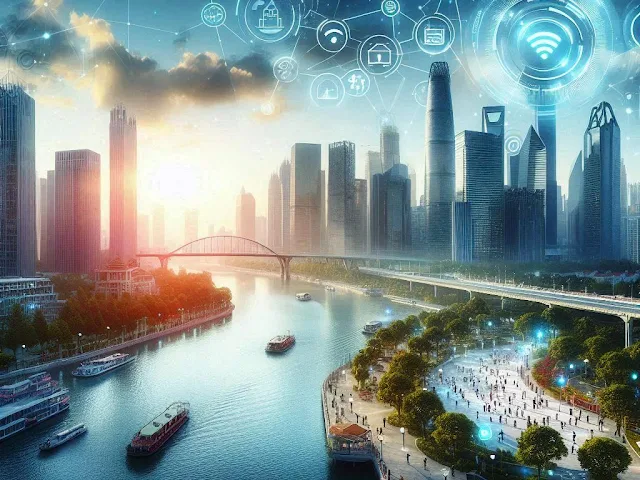 |
| “The Dawn of Smart Cities: How IoT is Shaping Urban Living” |
In an era of rapid urbanization, the concept of the smart city has emerged as a beacon of innovation, harnessing the power of the Internet of Things (IoT) to revolutionize urban living. The integration of IoT into urban environments is not just a trend; It is a transformative movement towards creating more efficient, sustainable and livable cities.
The IoT ecosystem consists of interconnected devices and sensors that collect and exchange data, providing rich insights into city operations. This network of smart devices enables real-time monitoring and management of urban infrastructure, from traffic lights to water supply systems. The result is a dynamic urban landscape that responds to the needs of its inhabitants and the challenges of city management.
One of the most significant impacts of IoT in urban settings is resource optimization. Smart meters, for example, are revolutionizing the way cities manage their energy consumption. These devices provide detailed information on energy consumption patterns, allowing for more informed decision-making and substantial cost savings and reduced carbon footprints.
Additionally, IoT is enhancing public safety and environmental monitoring. Equipped with sensors and cameras, smart poles enable rapid response to urban challenges, detecting and reporting problems from traffic congestion to air quality. The data collected through these devices is invaluable to city planners and policymakers, who can analyze trends and implement strategies to improve residents' quality of life.
Cities like Barcelona and Singapore are at the forefront of this revolution, using IoT to tackle urban problems. Installation of smart meters in parks in Barcelona increased water conservation by 25%, resulting in significant financial savings Singapore's Smart Nation initiative is another exemplary model, using IoT to improve everything from healthcare to transportation, setting a benchmark for smart city development worldwide.
Thedawn of smart cities is upon us, and IoT is the cornerstone of this new era. As cities continue to grow and develop, the adoption of IoT technology will play an important role in shaping urban life. It promises a future where cities are not just places to live but centers of efficiency, sustainability and innovation, providing a better quality of life for all.
For an in-depth look at how AI and IoT are changing urban lifestyles, explore the insights provided by industry experts and urban planners in the aforementioned articles. The journey towards smart cities is an exciting one, and it's only just beginning
Challenges in Smart City Implementation
The vision of smart cities is an attractive one, promising a future where urban environments are more responsive, efficient and sustainable. However, the road to realizing this vision is fraught with challenges that must be carefully navigated. Here are some of the major hurdles that cities face in their journey to become 'smart':
1. **Infrastructure Overhaul**: Existing urban infrastructure often requires significant upgrades to support the new technologies underlying smart cities. This can involve extensive construction work, which is expensive and disruptive.
2. **Data Security and Privacy**: Increased collection and analysis of data increases the risk of breaches and privacy concerns. Cities must implement robust security measures to protect sensitive data.
3. **Integration of technologies**: Smart cities rely on a complex network of interconnected technologies. Ensuring that these systems can work together seamlessly is a major technical challenge.
4. **Financing and Budgetary Constraints**: The financial investment required to develop smart city infrastructure is considerable. Ensuring adequate funding and managing the budget effectively is a constant struggle.
5. **Public-Private Partnership**: Collaboration between government agencies and private companies is crucial for smart city initiatives. However, aligning goals and interests can be difficult.
6. **Regulatory Barriers**: Navigating the legislative and regulatory landscape is often complex, with many initiatives requiring new policies or changes to existing laws.
7. **Digital divide**: There is a risk that smart city technologies may widen the gap between those who have access to digital services and those who do not, leading to social inequality.
8. **Public Engagement**: For smart cities to succeed, the public must be on board. Gaining citizens' trust and encouraging their active participation is a significant challenge.
9. **Maintenance and Maintenance**: Once implemented, smart city technologies require ongoing maintenance. This can be a logistical challenge and requires ongoing funding.
10. **Verifiability and Flexibility**: As cities grow and technology evolves, smart city solutions must be able to scale and adapt. Designing future-proof systems is a complex task.
These challenges are substantial, but not insurmountable. With careful planning, collaboration, and innovation, cities can overcome these barriers and move toward a smarter, more sustainable future. For more detailed insight into these challenges and potential solutions, the referenced articles provide a wealth of information.

